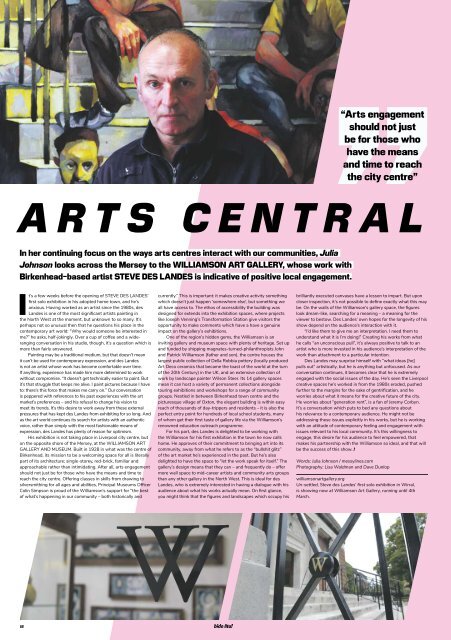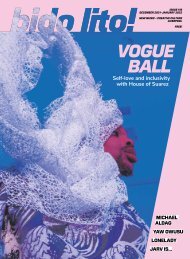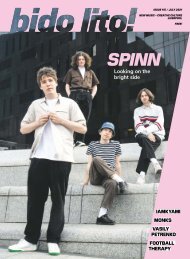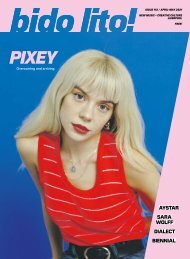Issue 85 / February 2018
February 2018 issue of Bido Lito! magazine. Featuring: RONGORONGO, MEHMET, NADINE SHAH, HOOKWORMS, WILLIAMSON ART GALLERY, DUDS and much more.
February 2018 issue of Bido Lito! magazine. Featuring: RONGORONGO, MEHMET, NADINE SHAH, HOOKWORMS, WILLIAMSON ART GALLERY, DUDS and much more.
You also want an ePaper? Increase the reach of your titles
YUMPU automatically turns print PDFs into web optimized ePapers that Google loves.
“Arts engagement<br />
should not just<br />
be for those who<br />
have the means<br />
and time to reach<br />
the city centre”<br />
ARTS CENTRAL<br />
In her continuing focus on the ways arts centres interact with our communities, Julia<br />
Johnson looks across the Mersey to the WILLIAMSON ART GALLERY, whose work with<br />
Birkenhead-based artist STEVE DES LANDES is indicative of positive local engagement.<br />
It’s a few weeks before the opening of STEVE DES LANDES’<br />
first solo exhibition in his adopted home town, and he’s<br />
anxious. Having worked as an artist since the 1980s, des<br />
Landes is one of the most significant artists painting in<br />
the North West at the moment, but unknown to so many. It’s<br />
perhaps not so unusual then that he questions his place in the<br />
contemporary art world: “Why would someone be interested in<br />
me?” he asks, half-jokingly. Over a cup of coffee and a wideranging<br />
conversation in his studio, though, it’s a question which is<br />
more than fairly answered.<br />
Painting may be a traditional medium, but that doesn’t mean<br />
it can’t be used for contemporary expression, and des Landes<br />
is not an artist whose work has become comfortable over time.<br />
If anything, experience has made him more determined to work<br />
without compromise. “It doesn’t get technically easier to paint. But<br />
it’s that struggle that keeps me alive. I paint pictures because I have<br />
to: there’s this force that makes me carry on.” Our conversation<br />
is peppered with references to his past experiences with the art<br />
market’s preferences – and his refusal to change his vision to<br />
meet its trends. It’s this desire to work away from these external<br />
pressures that has kept des Landes from exhibiting for so long. And<br />
as the art world continues its search for artists with an authentic<br />
voice, rather than simply with the most fashionable means of<br />
expression, des Landes has plenty of reason for optimism.<br />
His exhibition is not taking place in Liverpool city centre, but<br />
on the opposite shore of the Mersey, at the WILLIAMSON ART<br />
GALLERY AND MUSEUM. Built in 1928 in what was the centre of<br />
Birkenhead, its mission to be a welcoming space for all is literally<br />
part of its architecture; single-storey, red-brick, familiar and<br />
approachable rather than intimidating. After all, arts engagement<br />
should not just be for those who have the means and time to<br />
reach the city centre. Offering classes in skills from drawing to<br />
silversmithing for all ages and abilities, Principal Museums Officer<br />
Colin Simpson is proud of the Williamson’s support for “the best<br />
of what’s happening in our community – both historically and<br />
currently.” This is important: it makes creative activity something<br />
which doesn’t just happen ‘somewhere else’, but something we<br />
all have access to. The ethos of accessibility the building was<br />
designed for extends into the exhibition spaces, where projects<br />
like Joseph Venning’s Transformation Station give visitors the<br />
opportunity to make comments which have a have a genuine<br />
impact on the gallery’s exhibitions.<br />
One of the region’s hidden gems, the Williamson is an<br />
inviting gallery and museum space with plenty of heritage. Set up<br />
and funded by shipping magnates-turned-philanthropists John<br />
and Patrick Williamson (father and son), the centre houses the<br />
largest public collection of Della Robbia pottery (locally produced<br />
Art Deco ceramics that became the toast of the world at the turn<br />
of the 20th Century) in the UK, and an extensive collection of<br />
work by landscape painter Wilson Steer. Its 14 gallery spaces<br />
mean it can host a variety of permanent collections alongside<br />
touring exhibitions and workshops for a range of community<br />
groups. Nestled in between Birkenhead town centre and the<br />
picturesque village of Oxton, the elegant building is within easy<br />
reach of thousands of day-trippers and residents – it is also the<br />
perfect entry point for hundreds of local school students, many<br />
of whom get their first taste of gallery life via the Williamson’s<br />
renowned education outreach programme.<br />
For his part, des Landes is delighted to be working with<br />
the Williamson for his first exhibition in the town he now calls<br />
home. He approves of their commitment to bringing art into its<br />
community, away from what he refers to as the “bullshit glitz”<br />
of the art market he’s experienced in the past. But he’s also<br />
delighted to have the space to “let the work speak for itself.” The<br />
gallery’s design means that they can – and frequently do – offer<br />
more wall space to mid-career artists and community arts groups<br />
than any other gallery in the North West. This is ideal for des<br />
Landes, who is extremely interested in having a dialogue with his<br />
audience about what his works actually mean. On first glance,<br />
you might think that the figures and landscapes which occupy his<br />
brilliantly executed canvases have a lesson to impart. But upon<br />
closer inspection, it’s not possible to define exactly what this may<br />
be. On the walls of the Williamson’s gallery space, the figures<br />
look dream-like, searching for a meaning – a meaning for the<br />
viewer to bestow. Des Landes’ own hopes for the longevity of his<br />
show depend on the audience’s interaction with it.<br />
“I’d like them to give me an interpretation. I need them to<br />
understand what it is I’m doing!” Creating his works from what<br />
he calls “an unconscious pull”, it’s always positive to talk to an<br />
artist who is more invested in his audience’s interpretation of the<br />
work than attachment to a particular intention.<br />
Des Landes may surprise himself with “what ideas [he]<br />
pulls out” artistically, but he is anything but unfocused. As our<br />
conversation continues, it becomes clear that he is extremely<br />
engaged with the social issues of the day. He’s seen the Liverpool<br />
creative spaces he’s worked in from the 1980s eroded, pushed<br />
further to the margins for the sake of gentrification, and he<br />
worries about what it means for the creative future of the city.<br />
He worries about “generation rent”, is a fan of Jeremy Corbyn.<br />
It’s a conversation which puts to bed any questions about<br />
his relevance to a contemporary audience. He might not be<br />
addressing these issues explicitly in his works, but he is working<br />
with an attitude of contemporary feeling and engagement with<br />
issues relevant to his local community. It’s this willingness to<br />
engage, this desire for his audience to feel empowered, that<br />
makes his partnership with the Williamson so ideal, and that will<br />
be the success of this show. !<br />
Words: Julia Johnson / messylines.com<br />
Photography: Lisa Waldman and Dave Dunlop<br />
williamsonartgallery.org<br />
Un-settled, Steve des Landes’ first solo exhibition in Wirral,<br />
is showing now at Williamson Art Gallery, running until 4th<br />
March.<br />
18


















